Chapter 16: Monetary Policy
Chapter 16: Monetary Policy. Monetary Policy. Monetary policy consists of deliberate changes in the money supply to influence interest rates and thus the total level of spending in the economy. The goal is to achieve and maintain price-level stability, full employment, and economic growth.
Share Presentation
Embed Code
Link
Download Presentation
- aggregate demand curve leftward
- time period
- easy money policy
- wide range
- monetary policy arefed actions
- april

Faraday + Follow
Download Presentation
Chapter 16: Monetary Policy
An Image/Link below is provided (as is) to download presentation Download Policy: Content on the Website is provided to you AS IS for your information and personal use and may not be sold / licensed / shared on other websites without getting consent from its author. Content is provided to you AS IS for your information and personal use only. Download presentation by click this link. While downloading, if for some reason you are not able to download a presentation, the publisher may have deleted the file from their server. During download, if you can't get a presentation, the file might be deleted by the publisher.
Presentation Transcript
- Chapter 16: Monetary Policy
- Monetary Policy Monetary policy consists of deliberate changes in the money supply to influence interest rates and thus the total level of spending in the economy. The goal is to achieve and maintain price-level stability, full employment, and economic growth.
- Interest Rates • There are many types of interest rates in the U.S. economy that vary by purpose, size, risk, maturity, and taxability. • For simplicity, economists speak of a single interest rate. • The interest rate results from the interaction of money demand and money supply.
- Selected U.S. Interest Rates, April 2005
- The Demand for Money People demand money for two main reasons: to make purchases with it and to hold it as an asset. • The demand for money as a medium of exchange is called the transactions demand for money (Dt). • The amount of money people want to hold as a store of value is called the asset demand for money (Da).
- The Demand for Money • The main determinant of the amount of money demanded for transactions is the level of nominal GDP. • The transactions demand for money is vertical.
- The Demand for Money • Holding money incurs an opportunity cost; therefore, the amount of money demanded as an asset varies inversely with the rate of interest, which is the opportunity cost of holding money. • The asset demand for money is negatively sloped.
- The Demand for Money The sum of the transactions demand and assets demand for money equals the total demand for money (Dm). Dm = Dt + Da
- The Equilibrium Interest Rate • In the money market, the demand for money and the supply of money determine the equilibrium rate of interest. • The money supply, Sm, is a vertical line because the monetary authorities and financial institutions have provided the economy with some particular stock of money.
- The Equilibrium Interest Rate • The intersection of demand and supply in the money market determines equilibrium price, or the real interest rate (ic) – the inflation-adjusted price that is paid for the use of money over some time period.
- The Money Market
- Tools of Monetary Policy • The Federal Reserve can change the money supply and therefore alter interest rates in the economy. • The three tools of monetary control are: • Open-market operations • Reserve ratio • Discount rate
- Open Market Operations Open market operations consists of the buying and selling of U.S. government securities by the Fed for the purpose of carrying out monetary policy. Open market operations are the most important instrument for influencing the money supply.
- Open Market Operations • Buying securities increases the reserves of commercial banks. • Excess reserves allow the banking system to expand the money supply through loans. • Selling securities reduces the reserves of commercial banks. • Lower reserves result in a multiple contraction of the money supply.
- The Reserve Ratio • Changing the reserve ratio is a powerful technique of monetary control, although it is seldom used by the Fed. • Manipulation of the reserve ratio influences the ability of the commercial banks to lend.
- The Reserve Ratio • If the Fed raises the reserve ratio, the amount of required reserves that banks must keep increases. • Banks will either lose excess reserves, diminishing their ability to create money by lending, or reduce its checkable deposits due to deficient reserves, and therefore the money supply.
- The Reserve Ratio • If the Fed lowers the reserve ratio, the banks’ required reserves will decrease. • Banks with more excess reserves are able to create new money by lending.
- The Discount Rate • The discount rate is the interest rate the Federal Reserve Banks charge on the loans they make to commercial banks and thrifts. • Occasionally, Federal Reserve Banks makes short-term loans to commercial banks in their district; the Fed is considered the “lender of last resort.”
- The Discount Rate • In providing loans, the Federal Reserve Bank increases the reserves of the borrowing bank, enhancing its ability to extend credit. • From the commercial banks’ perspective, the discount rate is the cost of acquiring reserves.
- The Discount Rate • Increasing the discount rate discourages commercial banks from obtaining additional reserves through borrowing from the Federal Reserve Banks. • When the Fed raises the discount rate, it wants to restrict the money supply.
- Easy Money Policy • Easy money policy (or expansionary monetary policy)areFed actions designed to increase the money supply, lower interest rates, and expand real GDP. • These include buying securities, lowering the reserve ratio and lowering the discount rate. • Its purpose is to make loans less expensive and more available and thereby increase aggregate demand, output and employment.
- Tight Money Policy • The Fed can try to reduce aggregate demand by limiting or contracting the money supply. These actions are called a tight money policy (or restrictive monetary policy). • These include selling securities, increasing the reserve ratio and raising the discount rate. • The objective is to tighten the money supply in order to reduce spending and control inflation.
- Monetary Policy, Real GDP, and the Price Level • Monetary policy achieves its goals by affecting the market for money, investment, and equilibrium GDP. • The cause-effect chain in Figure 16.2 illustrates how monetary policy works.
- Monetary Policy, Real GDP, and the Price Level
- Effect of anEasy Money Policy • If real output in the economy is below the full-employment output, the economy must be experiencing a recession (a negative GDP gap) and unemployment; therefore, the Fed should institute an easy money policy. • To increase the money supply, the Fed can buy government securities, lower the legal reserve ratio, and lower the discount rate.
- Effect of anEasy Money Policy • Increasing the money supply will reduce interest rates and will boost investment. This will cause the aggregate demand curve to shift rightward, eliminating the negative GDP gap.
- Effect of aTight Money Policy • If real output in the economy is above the full-employment output, the economy has a positive GDP gap and demand-pull inflation; the Fed should institute a tight money policy. • The Fed will direct Federal Reserve Banks to undertake some combination of the following actions: (1) Sell government securities, (2) increase the legal reserve ratio, (3) increase the discount rate.
- Effect of aTight Money Policy • Decreasing the money supply will raise interest rates and cause investment to decline. The decrease in investment will shift the aggregate demand curve leftward, eliminating the excessive spending and halt demand-pull inflation, closing the positive GDP gap.
- Monetary Policy in Action • Monetary policy, a dominant component of U.S. national stabilization policy, has two key advantages over fiscal policy: • Speed and flexibility • Isolation from political pressure • Monetary policy can be quickly altered and is a more subtler and more politically neutral measure.
- The Focus on theFederal Funds Rate • Because the Fed can control the supply of reserves in the banking system and thus the Federal funds rate, it currently focuses monetary policy on altering the this interest rate as a need to stabilize the economy. • The Federal funds rate is the interest rate banks and thrifts charge one another on overnight loans made out of their excess reserves.
- The Focus on theFederal Funds Rate • If the Fed wants to increase the Federal funds rate, it sells securities in the open market to reduce bank reserves, and vice versa. • The Fed can target the Federal funds rate because it knows that interest rates in general (including the economy’s prime interest rate) typically rise and fall with that rate.
- The Focus on theFederal Funds Rate • The prime interest rate is the benchmark interest rate that banks and thrifts use as a reference point for a wide range of loans to businesses and individuals. • A change in the Federal funds rate will cause a similar change to the prime rate and other short-term interest rates.
- Problems and Complications • Monetary policy has certain limitations and real-world complications. • One problem is that monetary policy faces recognition lag and operational lag. • The Fed must be able to recognize and respond to changes in economic activity.
- Problems and Complications • Another problem is monetary policy suffers from cyclical asymmetry. • Cyclical asymmetry is the potential problem of monetary policy successfully controlling inflation during the expansionary phase of the business cycle but failing to expand spending and real GDP during the recessionary phase of the cycle.
- “Artful Management” or“Inflation Targeting”? • Alan Greenspan, in his role and Chairman of the Fed, has artfully managed the money supply to avoid escalating inflation or deep recession and deflation. • Some economists are concerned that this “artful management” may be a unique quality of Greenspan and that someone less insightful may not be as successful.
- “Artful Management” or“Inflation Targeting”? • Because of this, some feel the Fed should replace or combine the artful management of monetary policy with so-called inflation targeting—the annual statement of a target range of inflation for future years. • Some countries have already adopted inflation targeting as it increases the “transparency” of monetary policy and the central bank’s accountability.
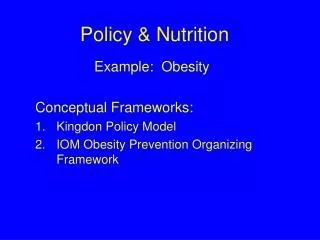
Policy & Nutrition
Policy & Nutrition Example: Obesity Conceptual Frameworks: Kingdon Policy Model IOM Obesity Prevention Organizing Framework What is Policy? Policy – Webster’s Wise, expedient, or prudent conduct or management
1.3k views • 74 slides
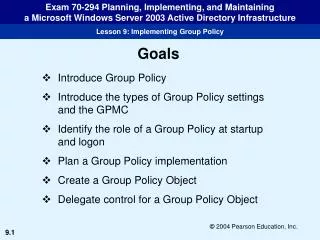
Goals
Goals Introduce Group Policy Introduce the types of Group Policy settings and the GPMC Identify the role of a Group Policy at startup and logon Plan a Group Policy implementation Create a Group Policy Object Delegate control for a Group Policy Object (Skill 1) Introducing Group Policy
1.31k views • 77 slides
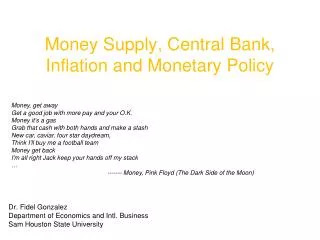
Money Supply, Central Bank, Inflation and Monetary Policy
Money Supply, Central Bank, Inflation and Monetary Policy
1.28k views • 44 slides
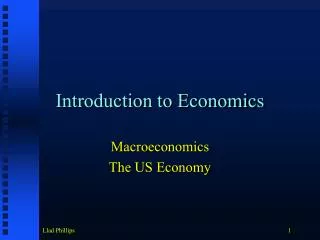
Introduction to Economics
Introduction to Economics. Macroeconomics The US Economy. Quiz: Median = 32. Outline. Economics in the News Review of Chapters 20, 21, and 24 The banking system and the Federal Reserve Monetary Policy: Does the Fed get the timing right?. Conference Board.
1.38k views • 89 slides
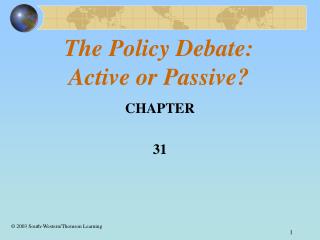
The Policy Debate: Active or Passive?
The Policy Debate: Active or Passive?. CHAPTER 31. © 2003 South-Western/Thomson Learning. Active versus Passive Policy. Proponents of the active approach argue that discretionary fiscal or monetary policy can reduce the costs of unstable private sector
1.24k views • 44 slides
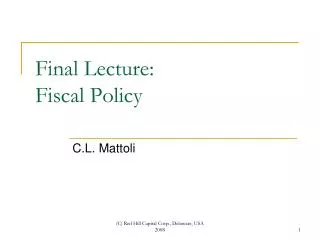
Final Lecture: Fiscal Policy
Final Lecture: Fiscal Policy. C.L. Mattoli. This week. Final Topic: Fiscal Policy Chapter 17, texbook. Learning objectives. Explain the nature and operation of both ‘discretionary’ and ‘supply-side’ fiscal policy
1.5k views • 93 slides

chapter
chapter. The International Monetary System. McGraw-Hill/Irwin Global Business Today, 5e. © 2008 The McGraw-Hill Companies, Inc., All Rights Reserved. 10. INTRODUCTION
2.15k views • 50 slides
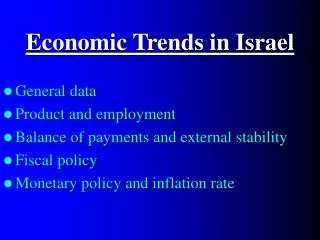
Economic Trends in Israel
Economic Trends in Israel. General data Product and employment Balance of payments and external stability Fiscal policy Monetary policy and inflation rate. Economic Trends in Israel. General data Product and employment Balance of payments and external stability Fiscal policy
1.35k views • 79 slides

Chapter 14
Chapter 14. Monetary Policy and the Federal Reserve System. Chapter Outline. Principles of Money Supply Determination Monetary Control in the United States The Conduct of Monetary Policy: Rules Versus Discretion. Principles of Money Supply Determination. Three groups affect the money supply
1.14k views • 93 slides
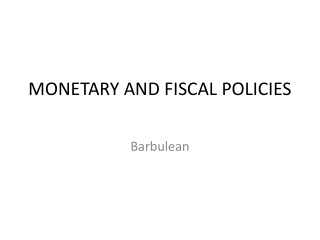
MONETARY AND FISCAL POLICIES
MONETARY AND FISCAL POLICIES. Barbulean. STAGES OF INFLATION. 1. CREEPING INFLATION (0%-3%) 2. WALKING INFLATION ( 3% - 7%) 3. RUNNING INFLATION (10% - 20 %) 4. HYPER INFLATION ( 20% and abv). TYPES OF INFLATION. 1. Demand Pull Inflation 2. Cost Push Inflation.
1.58k views • 115 slides
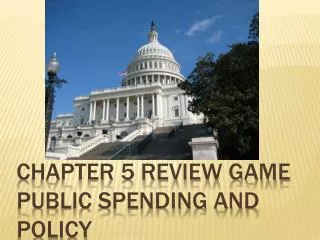
Chapter 5 Review Game Public Spending and Policy
Chapter 5 Review Game Public Spending and Policy. A situation in which a benefit or a cost associated with an economic activity spills over to third parties is called A) a public good. B) a merit good. C) an externality. D) the free rider problem.
951 views • 81 slides
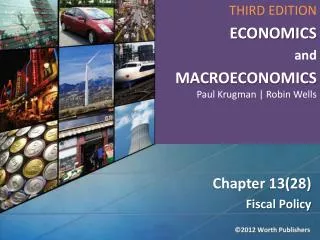
Chapter 13(28)
THIRD EDITION ECONOMICS and MACROECONOMICS Paul Krugman | Robin Wells. Chapter 13(28). Fiscal Policy. What fiscal policy is and why it is an important tool in managing economic fluctuations
1.25k views • 71 slides
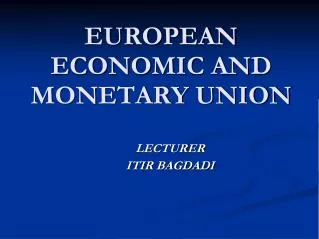
EUROPEAN ECONOMIC AND MONETARY UNION
EUROPEAN ECONOMIC AND MONETARY UNION. LECTURER ITIR BAGDADI. OVERVIEW. Economic Integration One of the most powerful dynamics of this era in world politics Nations are increasingly driven to unite their economies for greater efficiency and growth
1.24k views • 71 slides
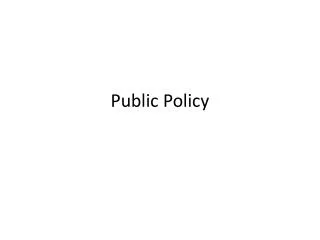
Public Policy
Public Policy. In this section I’ll outline, as best I can, what the term “public policy” refers to, and specifically address these three questions. What is public policy? What is the public policy process? What is policy analysis? Now, a definition.
1.48k views • 93 slides
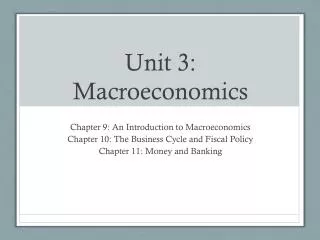
Unit 3: Macroeconomics
Unit 3: Macroeconomics. Chapter 9: An Introduction to Macroeconomics Chapter 10: The Business Cycle and Fiscal Policy Chapter 11: Money and Banking. Chapter 10: The Business Cycle and Fiscal Policy. Overview The macroeconomy and aggregate demand and supply analysis
1.41k views • 105 slides

Fiscal and Monetary Policy
Fiscal and Monetary Policy. Fiscal and Monetary Policy. The Nature of Fiscal Policy. THE NATURE OF FISCAL POLICY. The purpose of fiscal policy correcting a fundamental disequilibrium fine tuning Government finances budget deficits and surpluses financing a deficit the PSNCR.
1.86k views • 125 slides
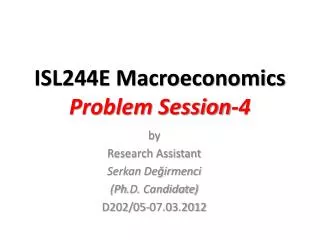
ISL244E Macroeconomics Problem Session -4
ISL244E Macroeconomics Problem Session -4. by Research Assistant Serkan Değirmenci ( Ph .D. Candidate ) D202/ 05-07 .0 3 .201 2. Today. GNH (2009) , Macroeconomics in Context - Chapter 11 : Money and Monetary Policy Review Questions (RQ) : 5-6-7- 8-9-10-11 (Page: 2 84-285 )
1.39k views • 13 slides

Charts Monetary Policy Report 2/2007
Charts Monetary Policy Report 2/2007. 1 Monetary policy assessments and strategy. Chart 1.1 Interval of uncertainty for underlying inflation. Highest and lowest indicator. 1) 12-month change. Per cent. Monthly figures. Jan 02 – May 07. Highest indicator. Lowest indicator.
1.55k views • 133 slides
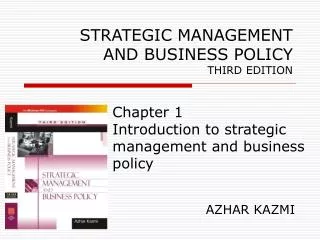
STRATEGIC MANAGEMENT AND BUSINESS POLICY THIRD EDITION
STRATEGIC MANAGEMENT AND BUSINESS POLICY THIRD EDITION. Chapter 1 Introduction to strategic management and business policy. AZHAR KAZMI. Learning objectives. Describe the historical development of strategic management and business policy in the world and in India
5.14k views • 14 slides
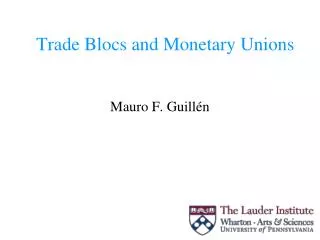
Trade Blocs and Monetary Unions
Trade Blocs and Monetary Unions. Mauro F. Guill én. Multilateralism: The GATT Rounds (General Agreement on Tariffs and Trade). * Ended with the creation of the WTO. ** Started by the WTO. The WTO. Dark green: founding members in 1995. (Today there are 153.). Types of Blocs.
1.15k views • 91 slides
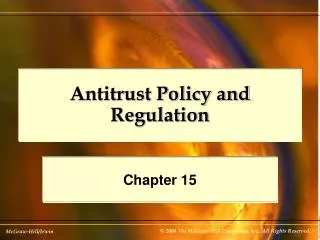
Antitrust Policy and Regulation
Antitrust Policy and Regulation. Chapter 15. Laugher Curve. Murphy’s Law of Economic Policy “Economists have the least influence on policy where they know the most and are agreed; They have the most influence on policy where they know the least and disagree most vehemently.”
1.57k views • 107 slides























